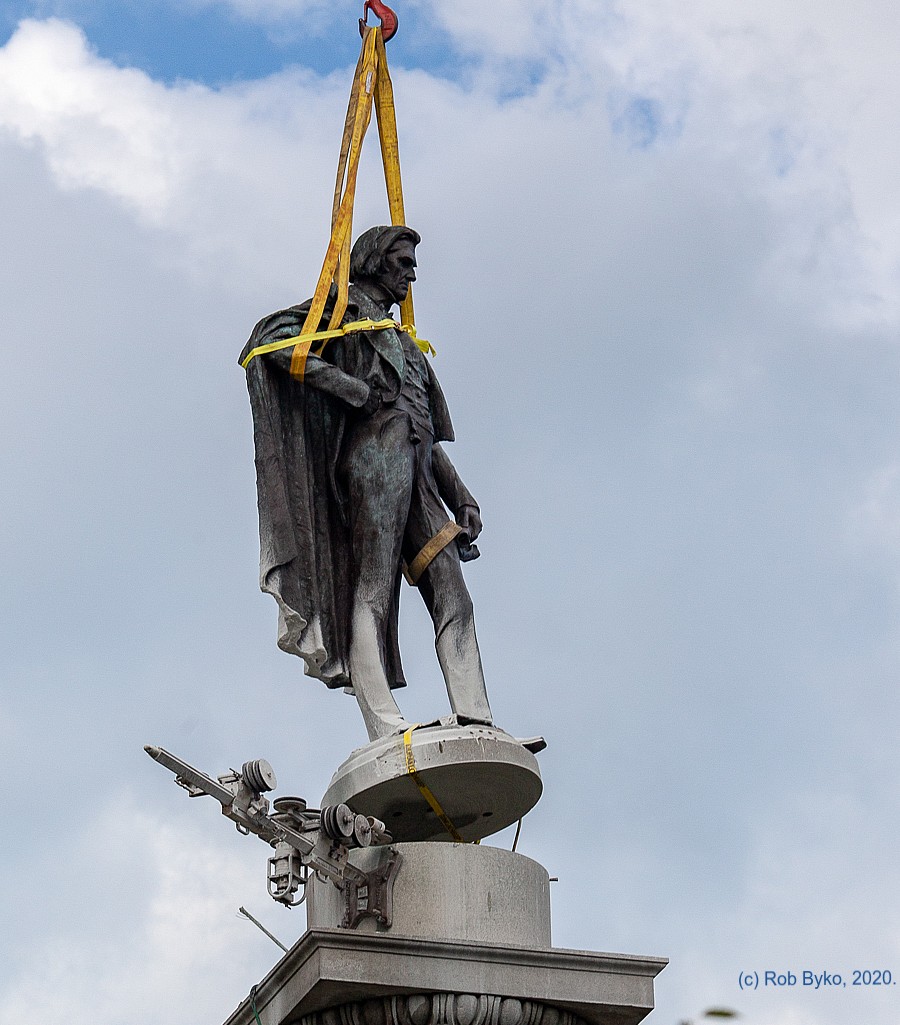
The statue of John C. Calhoun in Charleston, S.C., came down this week. Exclusive photo by Rob Byko.
By Elliott Brack
Editor and Publisher, GwinnettForum
JUNE 26, 2020 | Monuments, historical plaques and statues have been set up “in the heat of the moment” throughout the United States to honor individuals by people intent on recognizing the activities of what was seen as worthy individuals. But not all such recognitions are always deemed worthy several generations after the monument’s erection, when a more historical and more enlightened evaluation may be made of that honoree’s accomplishments.
 Placement of monuments or naming of bridges or intersections for individuals often happened years ago. It’s still happening today. You see signs as you travel around Georgia, as this road, this bridge, this statue recognizes individuals and their accomplishments. The naming is always considered worthy at the time. So, many such named recognitions and monuments do not stand the test of time. Some should never have been erected.
Placement of monuments or naming of bridges or intersections for individuals often happened years ago. It’s still happening today. You see signs as you travel around Georgia, as this road, this bridge, this statue recognizes individuals and their accomplishments. The naming is always considered worthy at the time. So, many such named recognitions and monuments do not stand the test of time. Some should never have been erected.
Up until recently, removing statuary was not forefront on the political agenda. There was no essential demand, method, pathway or demand to removing what may be now looked upon now as an unworthy recognition.
Yet the recent demands of what essentially are often peaceful protests should not be the method used to determine whether the statues should be taken down. After all, we are a nation of laws, not one directed by the action of an undisciplined mob, organized merely to disrupt long-standing honorees.
We were encouraged recently in DeKalb County, when a monument came down because of a court ruling, not pulled down by an angry mob. There were protests around the monument, but it was the legal ruling by a judge that initiated the removal of the statue.
That is as it should be.
We were also encouraged by the family of Confederate Gen. John B. Gordon, whose statue is on the state Capitol grounds, when the family itself recognizes Gordon’s questionable background. The family is to be commended for asking that the monument be removed.
If people think a monument or statue needs to be removed, for whatever reason, they should petition their local government to remove the offensive monument. However, undisciplined mobs should not dramatically pull down these statues. That’s not the American way, not the legal way. Several such petitions are circulating in Georgia now to remove racist statues. We commend such action. We must insist on legal governmental removal, not mob rule.
For the most part, every day people pass by many of these statues and monuments in the communities all across America, never thinking of them. Most were placed years ago, with people today unaware of who the monuments represent, or why.
On closer observation, we now recognize that all the statues so put up may not be considered worthy today. In the South, many of these statues were conceived at the turn of the Century, as the area emerged from the aftermath of the Civil War, and wanted to preserve a tradition that most of us do not consider worthy today.
At any rate, the removal of the statue may be today’s solution. But the statue itself if not the problem. It is a symptom, not the disease. If all the statues were destroyed, the underlying problem would still exist. It may take eons of time before the situation clears itself.
Meanwhile, the statues remain. Few think of them. Yet others are hurt by seeing a historical figure they feel unworthy honored with a monument. In they want action, they should turn to their civil government for redress and satisfaction.
- Have a comment? Send to: elliott@brack.net









Follow Us